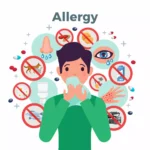CEO BLOG- Allergies…A Silent Killer
Many of you know I love to eat. And being Italian by heritage, I also love to cook, especially Italian food. I’m proud to have raised two doctors, one is a hemopathologist and the other an ob-gyn & Caduceus CMO. I’m equally proud that my love of cooking also spawned an executive chef.
Although I love making up my own recipes, I admit I also love to play around with cookbooks and now possess a modest collection. I especially treasure those books signed by the author/chef.
In my collection, I have two cookbooks by the Napa chef, Michael Chiarello. One is called Casual Cooking, my favorite recipe in it is Spuma Di Tonno – a bread spread that is life- changing, and a go-to opener for any meal. (If you want the recipe, just email me and I’ll gladly share!)
The other book of his is called Flavored Oils, teaching the art of making infused olive oils. This book in my collection was autographed when Mr. Chiarello met my chef son, Ryan. It says,
“Ryan- Infuse your cooking with passion!”
Ryan left the book in our kitchen when he moved out, so I am claiming ownership–at least until he reads this blog and comes home to reclaim it.
Earlier this month, the culinary world was shocked by Mr. Chiarello’s sudden death from an anaphylactic allergy reaction while home in Napa. He was only 61. As a physician, my first thought was, could this have been prevented?
To help solve this, a word about allergies.
Allergies may be environmental- bee stings come to mind. Or food based. The “big three” in the US are cow’s milk, eggs, and nuts. Surprisingly, shellfish is down the list aways, but definitely a player.
When most people eat shrimp, the proteins are harmlessly digested, and all is well. But in shrimp-allergic people, there is an overreaction of the immune system to the protein–we call allergens. With a little luck, this manifests only as hives, a stuffy nose, or watery eyes. A little Benadryl, maybe a Medrol dose pack in a more severe case, and all is back to normal.
But with enough sensitization, true anaphylaxis can occur. Once you’ve witnessed this, you’ll never forget. It may start with the just mentioned symptoms. But it rapidly may move on to on e or more of the following:
- feeling lightheaded or faint
- swelling of the mouth, throat or tongue, which can cause breathing and swallowing difficulties
- wheezing
- collapse and unconsciousness
- respiratory and cardiac arrest
Even scarier, in severe cases, this cascade can unfold in minutes.
To make matters worse, the prevalence of food allergies is increasing worldwide, approaching an epidemic level in some regions. In the U.S. alone, approximately 10% of children and adults suffer from food allergies.
People who know they are allergic are encouraged to carry EpiPens which usually work immediately. But what if you don’t know if you’re allergic?
Luckily, people with nut or shrimp allergies have had hives or wheezing from eating these in the past, saw a doctor, were tested, and know to avoid them and also carry the EpiPen. And it is true that with each peanut or bee sting the reactions are worse, so they have a warning they may be predisposed to anaphylaxis.
However, we are now finding out is it possible to have a true allergy and not be aware of it because they are asymptomatic allergies (such as Mr. Chiarello).
This condition is sometimes referred to as asymptomatic sensitization. In many cases, people with this condition may not even be aware that they have a food or bee sting hypersensitivity.
So yes, your body becomes sensitized with each exposure but does not cause a hive break out or wheezing attack which would alert you. You could eat shrimp many times before the anaphylactic attack manifests itself.
In Mr. Chiarello’s case, most people (including yours truly) thought–well he must have accidentally eaten something cooked in a pan that had previously been used with shellfish, or the kitchen had peanuts in it, where small grains got into his dish. If only he had an EpiPen!
But his family has gone public with the facts to encourage people to look into what allergens they may have. Mr. Chiarello had no known allergies. He had never exhibited any allergic symptoms previously. As a chef, he enjoyed almost all foods, with no previous issues.
He was apparently not eating at the time of his attack. There was no bee sting or contact with pets or plants. No antibiotics or other medications. He was simply at home when the attack occurred. Even a prompt response by 911 was not in time. His doctors have told the family they will probably never know the cause of the allergic attack.
This is not an isolated case. Anaphylaxis in people with no known allergies is one of these horror stories that make doctors shake their head. When there is no obvious or apparent cause of a reaction, it is termed idiopathic anaphylaxis.
In a recent AAFA study – one of the most accurate studies done on life-threatening reactions- found that almost 1 in 50 Americans is at risk for severe reactions. This study also found that many patients are not ready for this type of reaction.
To answer the question we posed at the start—is this preventable? Perhaps. If you feel you may be at risk or are looking for reassurance, here are a few steps you may consider.
1. Arrange a consultation with an allergist. They may want to do testing, or just give general advice.
2. Contact us for RAST testing–a blood test. This test checks for specific IgE antibodies to determine the substances that a person may be allergic to. It is an alternative to a skin prick test; it is not often recommended because of the high number of false positives. But it is fairly easy since it is a simple blood draw.
3. The most accurate would-be a skin test, usually starting with skin pricks. We have these here at Caduceus and they test for both environmental and food allergies. It should pick up most allergies that could lead to anaphylaxis, but of course there is no guarantee.
The RAST tests and allergy tests both run $400-500 depending on the exact order and patient. If it is not covered by your health plan, due to the large number of requests we have had recently, Caduceus is discounting its usual $400 price for the skin tests to $275 until November 30th. This would include both food and environmental allergens. You may arrange a Zoom call or in-person visit with your doctor, or you can also order it yourself, and the results will go to your doctor.
You may not feel a 2% chance of anaphylaxis is worth worrying about–or you may want reassurance you should have an EpiPen that may have saved Mr. Chiarello’s life. Either way, pay close attention to hives, wheezing, and watery eyes/nose. They are the first clues that you are at risk.
Oh, by the way, the ‘tonno” in the dish of Mr. Chiarello’s that I love, is Italian for “tuna.” It is basically tuna mousse. In tuna, beta (β) parvalbumin allergen is found in the muscle. I am thinking I need the testing for that allergen for sure!
I do know that if I don’t get tested, the next time I am in a restaurant, and they ask me “Do you have any food allergies?” –my answer is “How do I know?!!!
Self-book a consult with your provider to review your treatment options, request a consult with your primary care provider to discuss or book allergy testing directly by live chat from our website, request through your patient portal, or call our dedicated appointment line at 844-807-8558.
If you are experiencing hives, wheezing, and/or watery eyes or nose, seek same day treatment with a Zoom call or in-office visit at our urgent care partner, PDQ Urgent Care & More.
Email for my recipe.
Gregg DeNicola MD
CEO
Caduceus Medical Group
PDQ Urgent Care & More



